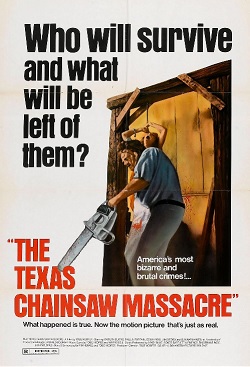
The Texas Chain Saw Massacre is a 1974 American independent horror film produced, co-composed, and directed by Tobe Hooper, who co-wrote it with Kim Henkel. The film stars Marilyn Burns, Paul A. Partain, Edwin Neal, Jim Siedow, and Gunnar Hansen. The plot follows a group of friends who fall victim to a family of cannibals while on their way to visit an old homestead. The film was marketed as being based on true events to attract a wider audience and to act as a subtle commentary on the era's political climate. Although the character of Leatherface and minor story details were inspired by the crimes of murderer Ed Gein, its plot is largely fictional.

Night of the Living Dead is a 1968 American independent horror film directed, photographed, and edited by George A. Romero, written by Romero and John Russo, produced by Russell Streiner and Karl Hardman, and starring Duane Jones and Judith O'Dea. The story follows seven people trapped in a farmhouse in rural Pennsylvania, under assault by reanimated corpses. Although the flesh-eating monsters that appear in the film are referred to as "ghouls", they are credited with popularizing the modern portrayal of zombies in popular culture.

Fleischer Studios was an American animation studio founded in 1929 by brothers Max and Dave Fleischer, who ran the pioneering company from its inception until its acquisition by Paramount Pictures, the parent company and the distributor of its films. In its prime, Fleischer Studios was a premier producer of animated cartoons for theaters, with Walt Disney Productions being its chief competitor in the 1930s.
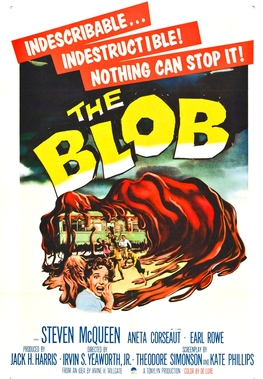
The Blob is a 1958 American science fiction horror film directed by Irvin S. Yeaworth Jr. from a screenplay by Theodore Simonson and Kate Phillips, based on an idea by Irving H. Millgate. It stars Steve McQueen and Aneta Corsaut and co-stars Earl Rowe and Olin Howland.

Zombi 2 is a 1979 English-language Italian zombie film directed by Lucio Fulci. It was adapted from an original screenplay by Dardano Sacchetti to serve as a sequel to George A. Romero's Dawn of the Dead (1978), which was released in Italy under the title Zombi. It stars Tisa Farrow, Ian McCulloch, and Richard Johnson, and features a score by frequent Fulci collaborator Fabio Frizzi. Frizzi's score has been released independently of the film, and he has performed it live on tour.
Color Classics are a series of animated short films produced by Fleischer Studios for Paramount Pictures from 1934 to 1941 as a competitor to Walt Disney's Silly Symphonies. As the name implies, all of the shorts were made in color format, with the first entry of the series, Poor Cinderella (1934), being the first color cartoon produced by the Fleischer studio. There were 36 shorts produced in this series.

The Big Trail is a 1930 American epic pre-Code Western early widescreen film shot on location across the American West starring 23-year-old John Wayne in his first leading role and directed by Raoul Walsh. It is the final completed film to feature Tyrone Power Sr. before his death in 1931, as well as his only sound role.

Associated Artists Productions, Inc. (a.a.p.) later known as United Artists Associated was an American distributor of theatrical feature films and short subjects for television. Associated Artists Productions was the copyright owner of the Popeye the Sailor shorts by Paramount Pictures, and the pre-1950 Warner Bros. Pictures film library, notably the pre-August 1948 color Looney Tunes and Merrie Melodies series of animated shorts, and the black-and-white Merrie Melodies shorts from Hugh Harman and Rudolf Ising, excluding Lady, Play Your Mandolin!.
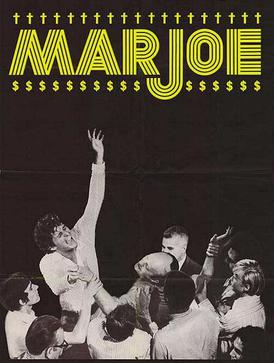
Marjoe is a 1972 American documentary film produced and directed by Howard Smith and Sarah Kernochan about the life of Pentecostal preacher Marjoe Gortner. It won the 1972 Academy Award for Best Documentary Feature.

The Flesh Eaters is a 1964 American horror/science fiction thriller, directed on a low budget by Jack Curtis and edited by future filmmaker Radley Metzger. The film contains moments of violence much more graphic and extreme than many other movies of its time, making it one of the first ever gore films.

Africa Screams is a 1949 American adventure comedy film starring Abbott and Costello and directed by Charles Barton that parodies the safari genre. The title is a play on the title of the 1930 documentary Africa Speaks! The supporting cast features Clyde Beatty, Frank Buck, Hillary Brooke, Max Baer, Buddy Baer, Shemp Howard and Joe Besser. The film entered the public domain in 1977.
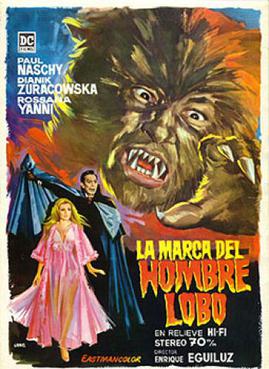
The Mark of the Wolfman, is a 1968 Spanish horror film, the first in a long series of films about the werewolf Count Waldemar Daninsky, played by Paul Naschy. The film was also known as Hell's Creatures, The Nights of Satan, The Vampires of Dr. Dracula and Frankenstein's Bloody Terror. Naschy originally suggested actress Barbara Steele for the part of the vampire countess Wandesa, but Aurora De Alba wound up getting the part.
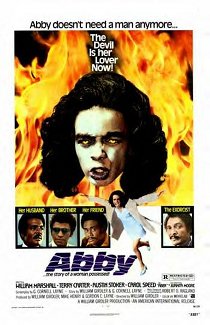
Abby is a 1974 American blaxploitation supernatural horror film about a woman who is possessed by a Yoruba sex spirit. The film stars Carol Speed as the title character, William H. Marshall and Terry Carter. It was directed by William Girdler, who co-wrote the film's story with screenwriter Gordon Cornell Layne.
Monster Mash is a 2000 Italian-American direct-to-video animated musical comedy horror film co-produced by DIC Entertainment, L.P. and Rai Fiction. It is an original story, based on the lore of Frankenstein, the Wolfman, and Count Dracula.
Jack the Ripper is a 1959 film produced and directed by Monty Berman and Robert S. Baker. It is loosely based on Leonard Matters' theory that Jack the Ripper was an avenging doctor. The black-and-white film stars Lee Patterson and Eddie Byrne and co-stars Betty McDowall, John Le Mesurier, and Ewen Solon. It was released in England in 1959, and shown in the U.S. in 1960.

Rock 'n' Roll is a 1959 Australian rock and roll concert film filmed at Sydney Stadium during the Lee Gordon's Rock 'n' Roll Spectacular shows, directed by Lee Robinson. Performers include Johnny O'Keefe, The Delltones, The Devils and Johnny Devlin. All acts are from either Australia or New Zealand. American singer Fabian's performance was also shot, but this was cut from the Australian version of the film as the producers did not wish to pay the fee his management requested. They did, however, discreetly keep the Fabian sequence intact in some versions of the film that were sent to New Zealand.

The Naked Witch is a 1964 American horror film produced by Claude Alexander, and written and directed by Larry Buchanan. It stars Libby Hall, Robert Short and Jo Maryman. The film was shot in 1960 and has a copyright date of 1961 but was not released until 1964. It tells the story of a university student who travels to Texas, where he inadvertently restores a dead witch to life. She then takes revenge on the Schöennig family, one of whom, her lover, had denounced her a century earlier. The student falls under the spell of the witch but recovers in time to save Kirska, the only remaining Schöennig, before he himself kills the witch again.

Crucible of Horror is a 1971 horror film directed by Viktors Ritelis, produced by Gabrielle Beaumont, and starring Michael Gough, Yvonne Mitchell, and Sharon Gurney. Its plot follows a mother who, along with her daughter, plots to murder her abusive husband at his hunting cottage.
Howard Avedis, born Hikmet Labib Avedis, was a film director, producer and author
Lawrence Zazelenchuk was a Canadian film director, screenwriter, film producer and prosthetic makeup artist. He is best known for the 1974 zombie cult film The Corpse Eaters.















